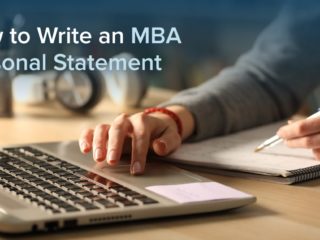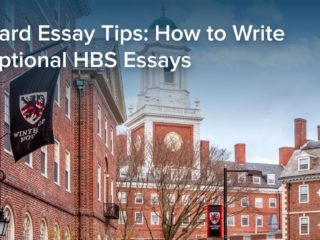| Getting your Trinity Audio player ready... |
Last Updated on February 25, 2025
Did you know? Your resume is an essential part of your MBA application. It provides business school admissions committees information about your career, education, and extracurriculars. However, many struggle with crafting the best resume for their MBA applications.
In this article, we’ll discuss successful MBA resume tips. Specifically, we’ll provide key components of a resume for full-time, two-year MBA applications. Additionally, we’ll share best practices for developing a stand-out resume. We’ll also discuss what not to do and answer common questions.
Here are the topics we’ll cover:
- What Are the Key Components of an MBA Resume?
- Best Practices for MBA Application Resumes
- What Not to Do When Writing an MBA Resume
- Key Takeaways
- Frequently Asked Questions (FAQ)
- What’s Next?
Let’s begin by discussing the key components of an MBA resume.
What Are the Key Components of an MBA Resume?
An MBA application resume has a header and 3 key sections. These sections include professional experience, education, and your volunteer activities, activities, and interests. Let’s detail what to include in each of these sections.
The Resume Header
Your MBA application resume header should be brief. It should include your full name, contact information (phone number and email address), and LinkedIn link. You do not need to include your full address, location, or a photo. You also do not need an MBA resume summary. Include these details in other areas of your application.
TTP PRO TIP:
Keep your MBA resume header brief.
The Professional Experience Section
The MBA admissions committee wants to learn about your career progression, first and foremost. So, include your professional experience at the top of your resume.
List your professional experiences in reverse chronological order, starting with your most recent. Include each of your roles since completing your degree. Specifically, list details about the company or organization, your title, and dates of employment. In your bullet points, detail achievements from each of your roles. We’ll discuss how to compose your bullet points later in this article.
This advice holds true for most situations. However, there may be some exceptions in certain cases. For example, if you are a deferred candidate or a program offers specific instructions, you may not need to follow this format.
TTP PRO TIP:
List your professional experiences in reverse chronological order.
The Education Section
Include your education section after your professional experience. List each of your degrees in reverse chronological order, starting with your most recent. Include the name of the institution/s attended, location, and dates attended.
List your degree, major, and minor (if applicable) in bullet points below. Additionally, list bullet points for academic achievements and key extracurriculars from college. Make sure that these bullet points include leadership positions from college. However, you can also include volunteer work, intramural sports, etc.
You do not need to include standardized test scores (ie. GMAT or GRE) or your GPA here. The MBA application will ask for this information elsewhere.
TTP PRO TIP:
Include leadership positions from college in the education section of your MBA resume.
The Volunteering, Activities, and Interests section
The last section of your MBA application resume will vary, depending on your activities. Accordingly, list information about your post-college interests. This may include volunteer work, activities, and personal interests. You may also include bullet points about languages spoken, technical skills, and certifications.
If you have leadership experience outside of work, include those details in the concluding section. Be sure to list the organization, dates of your involvement, and your achievements.
Many candidates overlook this section or don’t think it’s important. However, MBA admissions committees are interested in learning how you spend your time. Your interests and community involvement are an indication of how involved you will be on campus. Additionally, your activities are an important way to add diversity to the MBA cohort.
TTP PRO TIP:
Don’t overlook the importance of the volunteering, activities, and interests section.
Best Practices for MBA Application Resumes
If you follow these steps to draft your MBA application resume, you’re off to a great start! Next, let’s examine best practices to ensure that your experiences, education, and activities stand out and shine.
Read and Follow the Instructions for Each MBA Application
This may sound simple, but you must read the requirements for different MBA programs. Most applications ask for a one-page resume. Many programs do not have a preferred resume layout.
However, some MBA programs have specific resume requirements. For example, MIT Sloan’s MBA application asks candidates to list their education first. Additionally, candidates must use 10-point Times New Roman font.
To put your best foot forward, read and follow the instructions for each MBA program you apply to.
KEY FACT:
Most MBA programs require a one-page resume. However, EMBA programs will accept a 1-2 page resume.
Describe Accomplishments Rather Than Responsibilities
Make sure that your resume showcases your greatest achievements. Specifically, you must articulate your professional achievements in your bullet points, instead of responsibilities.
You may be wondering — what’s the difference between accomplishments and responsibilities? An accomplishment is something that you achieved, either individually or collectively. A responsibility is a day-to-day duty. Specifically, you must focus your MBA application resume on the former.
Use the ACR format when writing your resume bullet points. The acronym is short for Action → Context → Results:
- Action: Start each bullet point with a strong verb detailing your role, such as “Led”, “Created”, “Implemented”, etc.
- Context: Follow your action verb with information relating to the task and leading to the result.
- Result: Conclude the bullet with a result, measurable or otherwise. For example, you could describe annual growth of 15%. Alternatively, you could describe a holistic outcome.
TTP PRO TIP:
Follow the ACR format to emphasize your professional achievements.
Share Metrics Whenever Possible
MBA admissions committees want to understand where you’ve driven impact. The easiest way to showcase impact is through quantifiable results. For example, if you launched a campaign increasing sales by 15% annually, include that metric. Your results will be measured in dollars, percentages, or other ways.
We recommend that you use metrics in other ways throughout your bullet points. For example, if you lead a team, include the number of people you manage. Instead of stating that you led a team to increase sales, state that you led a team of 8 to increase sales by 15%.
TTP PRO TIP:
Use quantifiable results to showcase your professional impact.
Follow Industry Best Practices
The basic format of an MBA application resume will be similar, regardless of your experience. However, for certain industries, you may make modifications.
For example, consultants may not have enough space to list all of their projects. We recommend that consultants list achievements from representative projects.
TTP PRO TIP:
Follow the resume best practices for your specific industry.
Get Feedback From Another Reader
Once you’ve developed a strong draft of your resume, get feedback from another reader. Another person can evaluate whether your bullet points make sense. Ask a friend or family member to review your resume for logic and spelling. Alternatively, if you need an MBA resume template or are interested in an MBA resume review, book a free consultation with one of our expert consultants.
TTP PRO TIP:
To put the finishing touches on your resume, seek out feedback from other people.
Now that we know what to do to craft a stellar MBA resume, let’s discuss a few things to avoid.
What Not to Do When Writing an MBA Resume
So far, we’ve outlined sections to include in your resume and best practices. Next, we’ll discuss what not to do in your resume.
Avoid Using Industry or Technical Jargon
You must remember that MBA admissions committee members are not always industry experts. Therefore, we recommend that you use common terminology. Your resume should be understood by people who aren’t familiar with your industry.
For example, candidates with technical backgrounds should eliminate complex language from their resumes. Instead, we recommend that these candidates showcase their impact and business results.
TTP PRO TIP:
Make sure your resume is understandable to people who aren’t familiar with your industry.
Do Not Divulge Sensitive Information
Some organizations prevent employees from sharing specific information about their operations. These policies are in place due to confidential client relationships or sensitive subjects. If that is true for your situation, it’s OK not to share every detail in your resume.
For example, members of the military may not be able to share some specific information. Instead, we recommend that military service members highlight the business skills they used in each situation. Military service members can summarize their achievements in ways that do not share too much detail.
TTP PRO TIP:
Avoid sharing sensitive or confidential information in your resume.
Eliminate Flowery Language
We recommend that you avoid the temptation to use flowery or overly sophisticated language in your resume. This will not impress the MBA admissions committee. Instead, use straightforward language that is easy to read and understand. However, we’re not suggesting that your resume should be overly simplistic. Put simply, direct language eliminates confusion and misinterpretations of your achievements.
TTP PRO TIP:
Use straightforward language to ensure that your resume is easily understood.
Key Takeaways
We hope that our tips on the MBA resume format are helpful! If you follow these steps, you’ll create a stand-out resume for your MBA application. These best practices can be used when you’re writing an MBA student resume, an MBA cover letter, and an MBA graduate resume, too. These are essential tips that will pay dividends throughout your career.
Frequently Asked Questions (FAQ)
How do I write an MBA resume?
Read the steps in this article to build your MBA resume. Additionally, follow best practices and avoid common mistakes. If you need an MBA resume consultant, request a free consultation with Target Test Prep’s experienced team.
Do I need to include a resume objective or personal statement?
You do not need to include a resume objective or personal statement in your MBA resume. Most full-time MBA programs have a one-page resume limit. Instead, use this space to share your professional achievements, education, and other activities.
How long should an MBA resume be?
Most MBA programs ask for a one-page resume. However, some programs, such as executive MBA (EMBA) programs, will accept longer resumes. Read and follow the specific instructions for your target MBA programs.
What is the difference between a career resume and an MBA resume?
A career resume might include a summary and objectives section. Additionally, the bullet points in a career resume may include technical and industry information. Finally, the bullet points in a career resume may focus on job responsibilities.
Alternatively, an MBA resume follows the format and best practices outlined in this article. An MBA resume is written specifically for an admissions committee. Therefore, an MBA resume will not have industry jargon. Finally, an MBA resume will focus more on achievements, rather than responsibilities.
When do I send an MBA resume?
You will send an MBA resume with your application. Ensure that your resume has been proofread and is ready to upload before submitting!
What’s Next?
It’s not easy to create a standout resume for your MBA applications, but we can help! Target Test Prep’s experienced MBA admissions consultants will help you create an exceptional resume. Also, we’ll help develop other important MBA application materials.



